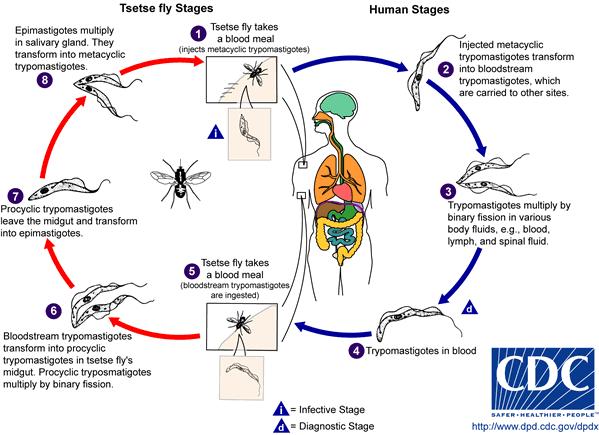Trypanosoma brucei
Articles that lack this notice, including many Eduzendium ones, welcome your collaboration! |
Classification
Higher order taxa
Kingdom: Protista
Phylum: Sarcomastigophora
Class: Zoomastigohora
Order: Kinetoplastida
Family: Trypanosomatidae
Species
Genus: Trypanosoma
Species: brucei
Trypanosoma brucei
Description and significance
[Describe the appearance, habitat, etc. of the organism, and why it is important enough to have its genome sequenced. Describe how and where it was isolated.
Include a picture or two (with sources) if you can find them.]
Trypanosoma brucei is a unicellular parasitic organism with no true tissues. It belongs to the protista kingdom and therefore has cell structures that are similar to the cells of many eukaryotes. T. brucei has no definite shape, it is mobile and has a single flagellum for locomotion.
T. brucei is often found in the rain forests and savannas with tropical climate. It is the cause of the disease trypanosomiasis, also called the African sleeping sickness. Therefore, most cases of trypanosomiasis are found in regions in Western and Central Africa.
Genome structure
Describe the size and content of the genome. How many chromosomes? Circular or linear? Other interesting features? What is known about its sequence? Does it have any plasmids? Are they important to the organism's lifestyle?
Cell structure and metabolism
T. brucei has organelles including endoplasmic reticulum, golgi apparatus, lysosome, nucleus, and a large mitochondrion. Its mitochondrion houses a unique structure called kinetoplast, where DNA is located. The kinetoplast is associated with the flagellum through microtubules. The organism has a flagellar basal body found posterior to the nucleus. The base of the flagellum is associated with the kinetoplast in the single large mitochondrion. The basal body plays a role in organizing spindles during mitosis.
Because of its animal-like cells, T. brucei has heterotrophic cells that require organic molecules for its source of energy. Studies have shown that it possesses some forms of energy producing enzymes. The organism acquires proline as a major energy source when it lives inside the gut of the tsetse fly. Since there is not much nutrients to be obtained from the gut of an insect, the parasite’s mitochondrion needs to carry out some type of metabolic pathways in order to generate sufficient energy. On the contrary, when nutrients become more abundant in mammalian host, the parasite can rely on the glucose from its host as its source of energy without having to undergo metabolic pathways to produce energy for its own use. This causes a severe malnutrition and rapid weight loss in the host.
Ecology
The parasitic organism survives in the gut of tsetse flies. When a tsetse fly takes a blood meal on the infected host, it becomes infected and goes on to disperse the parasite into the next mammalian host. Also, migration of infected individuals from Africa can spread T. brucei to other regions
Pathology
How does this organism cause disease? Human, animal, plant hosts? Virulence factors, as well as patient symptoms.
The parasitic organism infects mammals by using tsetse flies as intermediate hosts. During a blood meal, the infected Tsetse fly injects the parasite into the mammalian host. The organism is then transmitted into the bloodstream of mammalian host and can be carried to the lymph and spinal fluid through circulation. T. brucei begins to replicate in the bloodstream. As the organism migrates to other sites of the body through blood fluids, it begins to invade other body tissues and the central nervous system of the host. This results in symptoms include enlarged lymph nodes, swollen tissues, fever, headache, insomnia, and mental deterioration in patients.
Application to Biotechnology
Does this organism produce any useful compounds or enzymes? What are they and how are they used?
Current Research
Enter summaries of the most recent research here--at least three required
References
Bacteriol, J.(1992 February) “Mutual adjustment of glucose uptake and metabolism in Trypanosoma brucei grown in a chemostat”. Research Unit for Tropical Diseases, International Institute for Cellular and Molecular Pathology, Brussels, Belgium, 174(4): 1273–1279. Retrieved March 3, 2008, from PubMed Central Database.
"Life Cycle of Trypanosoma brucei." Chart. Retrieved March 3, 2008, from Centers for Disease Control and Prevention. <http://www.dpd.cdc.gov/dpdx/HTML/TrypanosomiasisAfrican.htm>.
Matthew, Keith R. "The developmental biology of Trypanosoma brucei." Retrieved March 3, 2008, from Journal of Cell Science 118 (2005): 283-290. <http://jcs.biologists.org/cgi/content/full/118/2/283#SEC6>
Prescott, Harley, Klein. (2005). Microbiology, Six Edition. New York: McGraw Hill Companies (pp.569-573)
